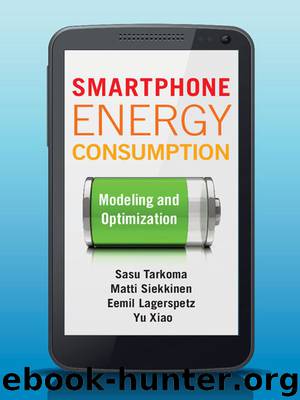Smartphone Energy Consumption: Modeling and Optimization by Sasu Tarkoma & Matti Siekkinen & Eemil Lagerspetz & Yu Xiao

Author:Sasu Tarkoma & Matti Siekkinen & Eemil Lagerspetz & Yu Xiao
Language: eng
Format: mobi, epub
Publisher: Cambridge University Press
Published: 2014-07-31T04:00:00+00:00
9.2 Deterministic power models of Wi-Fi network interface
On a mobile device, the energy consumption of wireless data transmission is mainly caused by the operations on WNIs. These operations, such as sending/receiving a unit of data through a WNI, are controlled by the software running on top of the WNIs, including the hardware drivers, the network protocol stack, and the network applications. Instead of going through the source code of the software in use, an alternative way of tracking the operations on WNIs is to monitor the traffic going through them. Packet-level traffic traces can be collected using packet analyzers, like tcpdump2 and the open-source Application Resource Optimizer (ARO) from AT&T Labs,3 which have been ported to many mobile OSs, including Android and iOS. These packet analyzers can capture packets and analyze the packet size, packet arrival time, source/destination IP address, and other information indicated in the header of each packet.
We use the Wi-Fi interface as an example to explain how to obtain the values of the parameters listed in Eq. (9.1) from packet-level traffic traces. We assume that the Wi-Fi interface adopts adaptive PSM (described in Section 7.3.1) and its state machine can be illustrated as shown in Figure 7.8. The modeling process consists of two steps.
First, detect the transmit and receive modes based on the transmission direction of the packets. The transmission direction can be worked out by comparing the source/destination IP address with the IP address assigned to the smartphone. After that, the time spent in the transmit and receive modes is determined by the packet sizes and the processing capacity of the Wi-Fi interface in the corresponding operating mode. The processing capacity indicates how fast the Wi-Fi interface can handle packets locally. It is different from the end-to-end network throughput. Given an operating mode, either TRANSMIT or RECEIVE, its processing capacity can be assumed to be fixed. If the TRANSMIT and/or RECEIVE mode includes sub-states, each of which corresponds to a certain processing capacity, each sub-state is treated as an individual operating mode.
Second, detect IDLE and SLEEP modes based on packet intervals and the PSM timeout, and count the transitions that occur during the data transmission. Only if the packet interval is bigger than the PSM timeout does the transition from IDLE to SLEEP mode occur and the packet interval is divided into two parts. The one equal to the PSM timeout is spent in the IDLE mode, while the rest of the interval is spent in the SLEEP mode. Depending on whether the network interface stays in IDLE or SLEEP mode at the end of each packet interval, the transition from IDLE/SLEEP mode to TRANSMIT/RECEIVE mode can also be derived.
The above method can also be applied for the power analysis of the 3G WCDMA network interface [17], whose power state is defined by the RRC protocol [18]. Similar to the adaptive PSM for Wi-Fi, the operating mode when sending/receiving data can be detected by comparing the traffic volume with the ones that can be handled by CELL_PCH and CELL_FACH.
Download
Smartphone Energy Consumption: Modeling and Optimization by Sasu Tarkoma & Matti Siekkinen & Eemil Lagerspetz & Yu Xiao.epub
This site does not store any files on its server. We only index and link to content provided by other sites. Please contact the content providers to delete copyright contents if any and email us, we'll remove relevant links or contents immediately.
On Writing A Memoir of the Craft by Stephen King(4864)
The Doodle Revolution by Sunni Brown(4689)
A Simplified Life by Emily Ley(4099)
Mummy Knew by Lisa James(3634)
Marijuana Grower's Handbook by Ed Rosenthal(3623)
Better Homes and Gardens New Cookbook by Better Homes & Gardens(3527)
Figure Drawing for Artists by Steve Huston(3384)
Paper Parties by Erin Hung(3371)
Draw Your Day by Samantha Dion Baker(3290)
The Genius of Japanese Carpentry by Azby Brown(3226)
Japanese Design by Patricia J. Graham(3112)
The Code Book by Simon Singh(3077)
Dangerous Girls by Haas Abigail(2980)
Lions and Lace by Meagan Mckinney(2925)
The Curated Closet by Anuschka Rees(2915)
How to Make Your Own Soap by Sally Hornsey(2830)
The Checklist Manifesto by Atul Gawande(2780)
The Wardrobe Wakeup by Lois Joy Johnson(2733)
Zero to Make by David Lang(2726)
